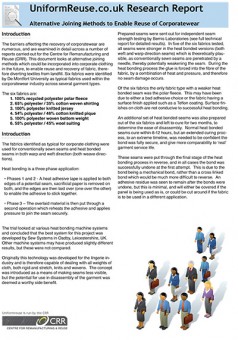Reports
Uniform Reuse has put together information on the 'best practice' approaches to corporate wear, and guidance on how to improve the sustainability of this type of clothing. Our information will help designers, buyers, wearers and end-of-life processors, as we believe all parts of the supply chain play a vital role in helping to reduce the environmental impact of corporate wear.

Alternative joining
With corporate clothing being highly branded, it can be difficult to reuse. Logo removal can be costly and resource intensive, and in some cases causes enough damage to inhibit reuse entirely. One idea worth considering is to disassemble the garments, which allows whole panels of fabric to be reused, with only the logoed panel needing to be replaced. Because it’s very time consuming to unpick conventional stitching, alternative joining mechanisms need to be considered for this process to be feasible. One option is heat bonding, in which adhesive and pressure are used in a reversible technique that could make disassembly easier.
Heat bonding is currently expensive, so is only suitable for higher value clothing. It might, for example, be viable for repair of protective workwear, such as garments treated with fire retardant finishes. These garments can be very costly to produce, with numerous fibre types and expensive treatments applied to them. A tear in one panel typically results in the garment being thrown away: heat bonding may allow the removal and replacement of the torn panel so that the garment life is extended.
Different fabric types – those typically utilised by corporatewear producers – have been trialled with heat bonding, to great success. With five of the six fabric types, joins were more durable than conventional seams, yet all could be simply reversed in a one-step procedure. The full trial is discussed here as the first pdf and the detailed laboratory results (the Bemis Report) second
Different fabric types - those typically utilised by corporatewear producers - have been trialled with heat bonding, to great success. With five of the six fabric types, joins were more durable than conventional seams, yet all could be simply reversed in a one-step procedure. The full trial is discussed here.
Download pdf (856kB)To read the detailed laboratory results see the Bemis Report
Download pdf (42kB)

